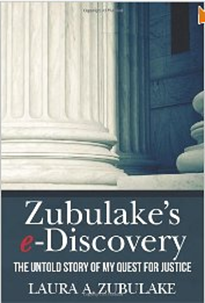Yesterday, we discussed a couple of cases within a month’s time where the New York Appellate Division has embraced the federal standards of Zubulake v. UBS Warburg LLC, 220 FRD 212. Those of us who have been involved in litigation support and discovery management for years are fully aware of the significance of the Zubulake case and its huge impact on discovery of electronic data. Even if you haven’t been in the industry for several years, you’ve probably heard of the case and understand that it’s a significant case. But, do you understand just how many groundbreaking opinions resulted from that case? For those who aren’t aware, let’s take a look back.
The plaintiff, Laura Zubulake, filed suit against her former employer UBS Warburg, alleging gender discrimination, failure to promote, and retaliation. Southern District of New York Judge Shira Sheindlin's rulings in this case are the most often cited in the area of electronic discovery, and were issued prior to the 2006 amendments to the Federal Rules of Civil Procedure. That’s somewhat like establishing laws before the Ten Commandments! The important opinions related to eDiscovery are commonly known as Zubulake I, Zubulake III, Zubulake IV and Zubulake V. Here is a summary of each of those opinions:
Zubulake v. UBS Warburg, 217 F.R.D. 309 (Zubulake I) and Zubulake v. UBS Warburg, 216 F.R.D. 280 (S.D.N.Y. 2003) (Zubulake III)
The plaintiff argued that key evidence was located in various emails exchanged among employees of UBS, the defendant. Initially, the defendant produced about 350 pages of documents, including approximately 100 pages of email, but the plaintiff produced approximately 450 pages of email correspondence on her own. To address the discrepancy, the plaintiff requested for UBS to locate the documents that existed in backup tapes and other archiving media.
The defendant, arguing undue burden and expense, requested the court to shift the cost of production to the plaintiff, citing Rowe Entertainment v. The William Morris Agency, 205 F.R.D. 421 (S.D.N.Y. 2002). In May 2003, the court ruled stating that whether the production of documents is unduly burdensome or expensive "turns primarily on whether it is kept in an accessible or inaccessible format". The court determined that the issue of accessibility depends on the media on which data are stored. It described five categories of electronic media, as follows:
- Online data, including hard disks;
- Near-line data, including optical disks;
- Offline storage, such as magnetic tapes;
- Backup tapes;
- Fragmented, erased and damaged data.
The last two categories were considered inaccessible as they were not readily available and thus subject to cost-shifting. Discussing the Rowe decision, the court concluded that it needed modification and created a new seven factor balance test for cost-shifting:
- The extent to which the request is specifically tailored to discover relevant information;
- The availability of such information from other sources;
- The total cost of production, compared to the amount in controversy;
- The total cost of production, compared to the resources available to each party;
- The relative ability of each party to control costs and its incentive to do so;
- The importance of the issues at stake in the litigation; and
- The relative benefits to the parties of obtaining the information.
The defendant was ordered to produce, at its own expense, all responsive email existing on its servers, optical disks, and five backup tapes as selected by the plaintiff. The court would only conduct a cost-shifting analysis after the review of the contents of the backup tapes.
In July 2003, Zubulake III applied the cost-shifting test outlined in Zubulake I based on the sample recovery of data from five backup tapes. After the results of the sample restoration, both parties wanted the other to fully pay for the remaining backup email. The sample cost the defendant about $19,003 for restoration but the estimated costs for production was $273,649, including attorney and paralegal review costs. After applying the seven factor test, it determined that the defendant should account for 75 percent of the restoration and searching costs, excluding attorney review costs.
Zubulake v. UBS Warburg, 220 F.R.D. 212 (S.D.N.Y. 2003) (Zubulake IV)
During the restoration effort, the parties discovered that some backup tapes were no longer available. The parties also concluded that relevant emails created after the initial proceedings had been deleted from UBS's email system and were only accessible on backup tapes. The plaintiff then sought an order requiring UBS to pay for the total costs of restoring the remaining backup tapes and also sought an adverse inference instruction against UBS and the costs for re-deposing some individuals required because of the destruction of evidence.
In October 2003, Judge Scheindlin found that the defendant had a duty to preserve evidence since it should have known that it would be relevant for future litigation. However, at the time, she concluded that the plaintiff failed to demonstrate that the lost evidence supported the adverse inference instruction claim. But, she did order the defendant to cover the costs as claimed by the plaintiff.
Zubulake v. UBS Warburg, 2004 WL 1620866 (S.D.N.Y. July 20, 2004) (Zubulake V)
In July 2004, Judge Scheindlin ruled that UBS had failed to take all necessary steps to guarantee that relevant data was both preserved and produced, and granted the plaintiff's motion for adverse inference instruction sanctions, sought in Zubulake IV, due to the deleted evidence (emails and tapes) and inability to recover key documents during the course of the case.
The court also indicated that defense counsel was partly to blame for the document destruction because it had failed in its duty to locate and preserve relevant information. In addressing the role of counsel in litigation, the court stated that "[c]ounsel must take affirmative steps to monitor compliance so that all sources of discoverable information are identified and searched" by ensuring all relevant documents are discovered, retained, and produced and that litigators must guarantee that relevant documents are preserved by instituting a litigation hold on key data, and safeguarding archival media.
In the final instructions to the jury Judge Scheindlin instructed in part, "[i]f you find that UBS could have produced this evidence, the evidence was within its control, and the evidence would have been material in deciding facts in dispute in this case, you are permitted, but not required, to infer that the evidence would have been unfavorable to UBS." In addition, monetary sanctions were awarded to the plaintiff for reimbursement of costs of additional re-depositions and of the motion leading to this opinion, including attorney fees. The jury found in the plaintiff’s favor on both claims awarding compensatory and punitive awards totaling $29.2 million.
Judge Scheindlin’s opinions in Zubulake, including definitions of accessible and inaccessible data, the seven factor balance test for cost shifting and definition of counsel’s obligation for preserving data, have been referenced in numerous cases since and have provided guidance to organizations preparing for litigation. For any of you who may not have fully understood the significance of the case, I hope this look back was helpful.
So, what do you think? Did you learn something new about Zubulake? Please share any comments you might have or if you’d like to know more about a particular topic.
Disclaimer: The views represented herein are exclusively the views of the author, and do not necessarily represent the views held by CloudNine Discovery. eDiscoveryDaily is made available by CloudNine Discovery solely for educational purposes to provide general information about general eDiscovery principles and not to provide specific legal advice applicable to any particular circumstance. eDiscoveryDaily should not be used as a substitute for competent legal advice from a lawyer you have retained and who has agreed to represent you.











